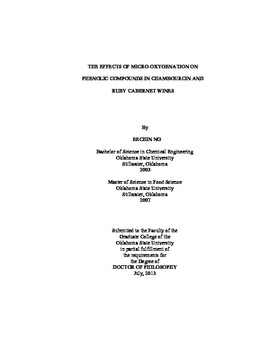| dc.contributor.advisor | McGlynn, William G. | |
| dc.contributor.author | Ng, Eechin | |
| dc.date.accessioned | 2014-09-24T14:17:01Z | |
| dc.date.available | 2014-09-24T14:17:01Z | |
| dc.date.issued | 2013-07 | |
| dc.identifier.uri | https://hdl.handle.net/11244/11030 | |
| dc.description.abstract | The effect of micro-oxygenation on phenolic compounds was evaluated in wines made from a traditional vinifera variety, Ruby Cabernet, and a French-American hybrid variety, Chambourcin. Skin contact times (SCT) prior to pressing were 6 and 12 days. Injection of oxygen commenced after pressing and occurred daily for 16 weeks. Three levels of oxygen were applied: control, low (2.1 mL O2 per fermentation vessel per day) and high (21 mL O2 per vessel per day). Samples were collected weekly over 16 weeks and an additional sample was collected after approximately 18 months of storage. | |
| dc.description.abstract | Our analyses showed that in both wines oxygenation treatment generally did not significantly affect the content of most of the phenolic compounds analyzed during the initial 16 weeks of treatment. After 18 months, oxygenated Chambourcin wines had lower monomeric anthocyanins compared to controls. Oxygenated 12-day SCT Ruby Cabernet wines had lower concentrations of monomeric anthocyanins than controls from 16 weeks on and after 18 months storage. Oxygenated 12-day SCT Ruby Cabernet wines also had lower concentrations of long polymeric pigments (LPP) than controls after 18 months of storage. Tannins in 12-day SCT Chambourcin wines showed significant oxygen effect for the 16-week experimental period, but none after storage. In terms of antioxidant capacity, oxygenation effect was also insignificant. Liquid chromatography analysis of individual phenolic compounds also showed that oxygenation had an insignificant impact on most of the phenolics content and composition after 16 weeks. Catechin, myricetin and quercetin were the major phenolics identified. | |
| dc.description.abstract | Although the observed effects of micro-oxygenation were generally consistent with an accelerated ageing process, quality-related effects on the phenolic compounds in both wines were not readily apparent from the chemical testing performed. It is possible that an experimental design with a lone SCT treatment and with varying oxygenation levels could better demonstrate the effects of the oxygenation treatment. As chemical analyses alone cannot fully describe the quality of a wine, sensory testing may be beneficial in detecting differences. | |
| dc.format | application/pdf | |
| dc.language | en_US | |
| dc.rights | Copyright is held by the author who has granted the Oklahoma State University Library the non-exclusive right to share this material in its institutional repository. Contact Digital Library Services at lib-dls@okstate.edu or 405-744-9161 for the permission policy on the use, reproduction or distribution of this material. | |
| dc.title | Effects of micro-oxygenation on phenolic compounds in Chambourcin and Ruby Cabernet wines | |
| dc.contributor.committeeMember | Bowser, Tim | |
| dc.contributor.committeeMember | Goad, Carla Lynn | |
| dc.contributor.committeeMember | Lucas, Edralin A. | |
| osu.filename | Ng_okstate_0664D_12964.pdf | |
| osu.accesstype | Open Access | |
| dc.type.genre | Dissertation | |
| dc.type.material | Text | |
| thesis.degree.discipline | Food Science | |
| thesis.degree.grantor | Oklahoma State University | |
